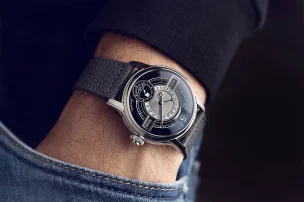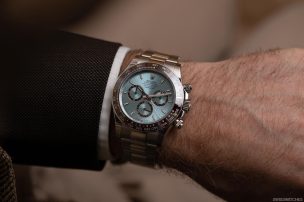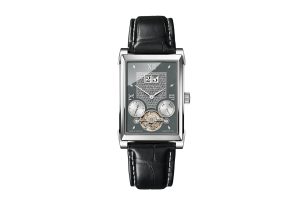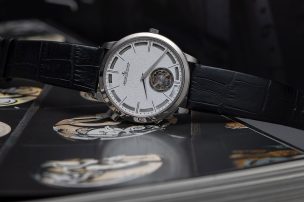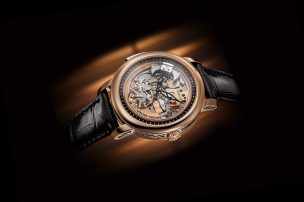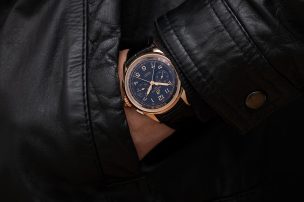
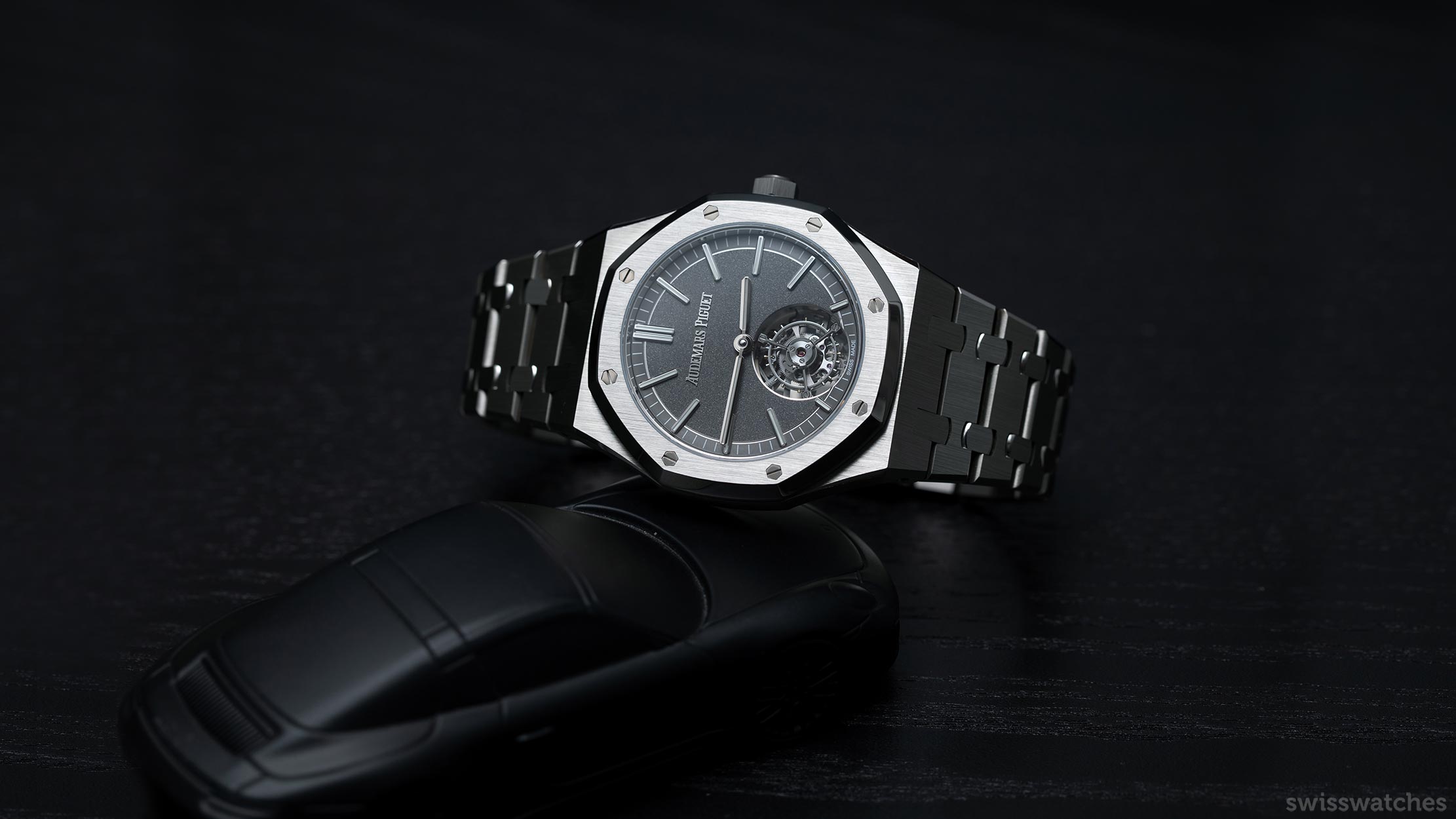
In The Metal: Audemars Piguet Royal Oak Selfwinding Flying Tourbillon Titanium
It’s safe to say that the watch community knows Audemars Piguet’s Royal Oak pretty well. From its octagonal bezel, exposed hexagonal screws, and diver’s helmet inspiration to the tapisserie dial, we know the design code inside out. Except the latter element is nowhere in sight on the Audemars Piguet Royal Oak Selfwinding Flying Tourbillon in titanium (Ref. 26530TI). This much-discussed model bids au revoir to the watch’s traditional tapisserie decoration. For the first time ever in the line’s history, this one-of-a-kind Royal Oak alternatively opts for a slate-grey, sandblasted dial.
Understanding the Ref. 26530TI
First introduced last year, this 41 mm x 10.4 mm titanium AP has two siblings in stainless-steel or pink gold. Interestingly, these latter two versions showcase the Royal Oak‘s classic tapisserie dial, hinting that the horology house anticipated that the titanium version would be the star of the trio.
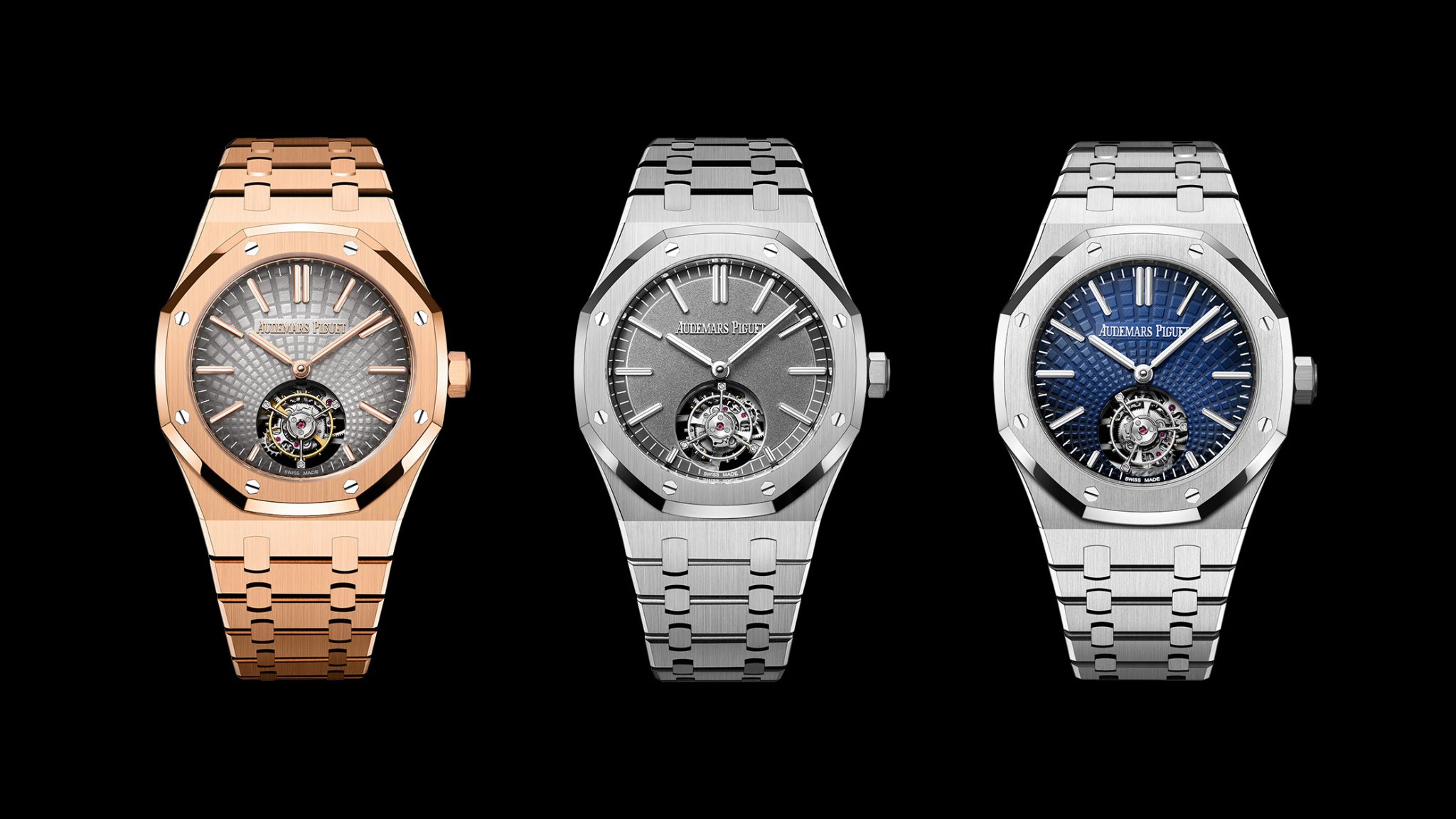
Nevertheless, all three models do share one unique selling point within the Royal Oak family. The clue is in the name; they integrate a flying tourbillon with a self-winding movement. Audemars Piguet’s first automatic flying tourbillon wristwatch made its appearance in 2018 in the Royal Oak Concept collection. However, the main Royal Oak line only ever used manual winding calibres in its flying tourbillon models – until now.
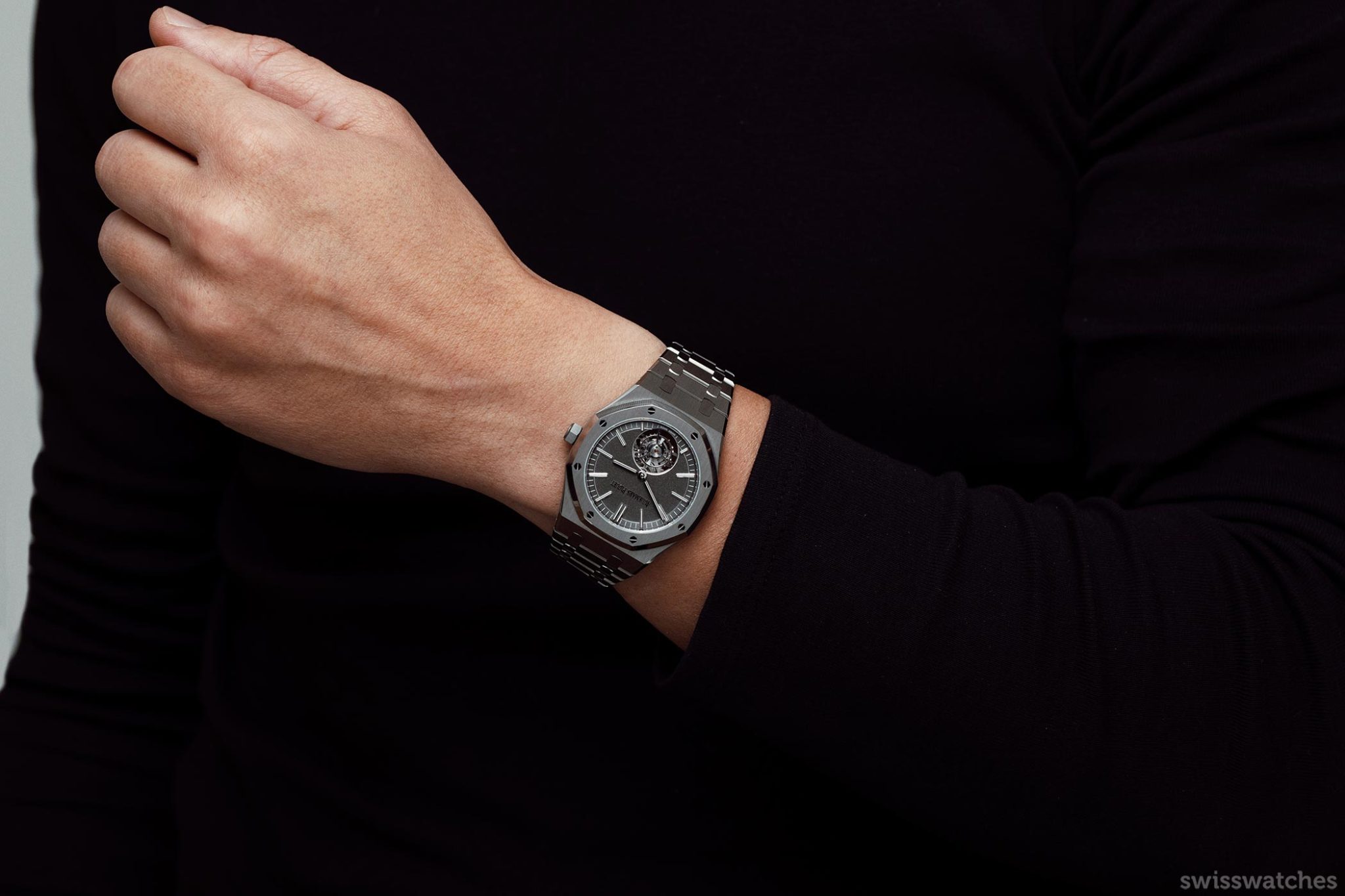
A Controversial Material: Case and Bracelet
Before getting down to the details of the flying tourbillon, let’s discuss the use of Grade 5 titanium, a material rarely used in the line. After all, the Royal Oak Selfwinding Flying Tourbillon doesn’t only stand out for its dial, but also its case and bracelet material. While its siblings use the heavier materials of steel and pink gold, the titanium version weighs a mere 116 g.
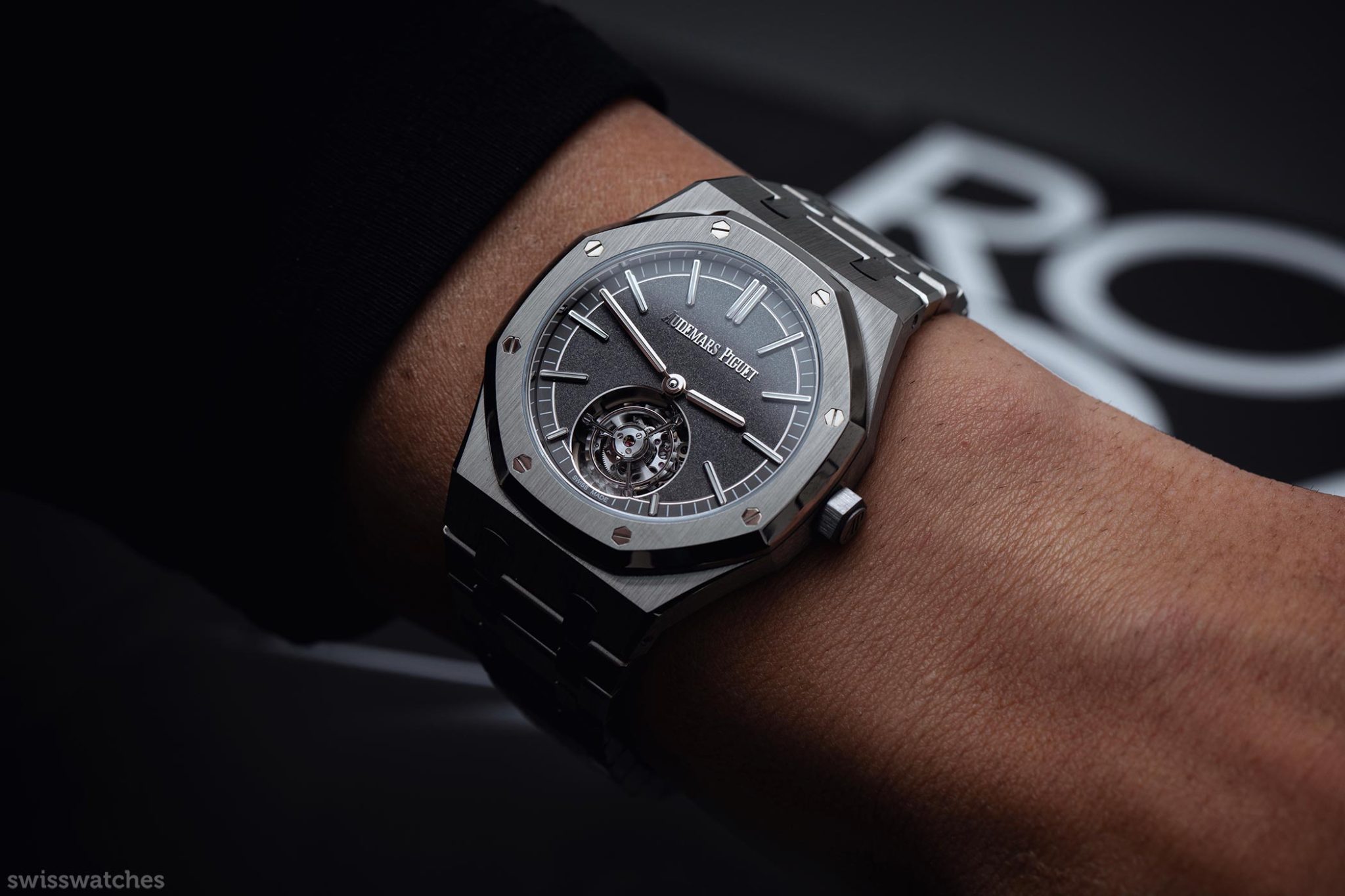
This in itself is a talking point. The feel of the bracelet is incredibly light, even delicate. Of course, in reality, we are talking about a material that has an excellent strength-to-weight ratio (i.e it’s 60% stronger than aluminium). Furthermore, it’s non-magnetic and highly resistant to corrosion from the likes of oxygen, water and chlorine. Yet that doesn’t stop this ultra-light watch from arguably feeling somewhat less sumptuous than its siblings. While material is a matter of taste, the titanium watch is likely to first and foremost entice watch collectors above individuals who are looking for their one luxury Swiss watch.
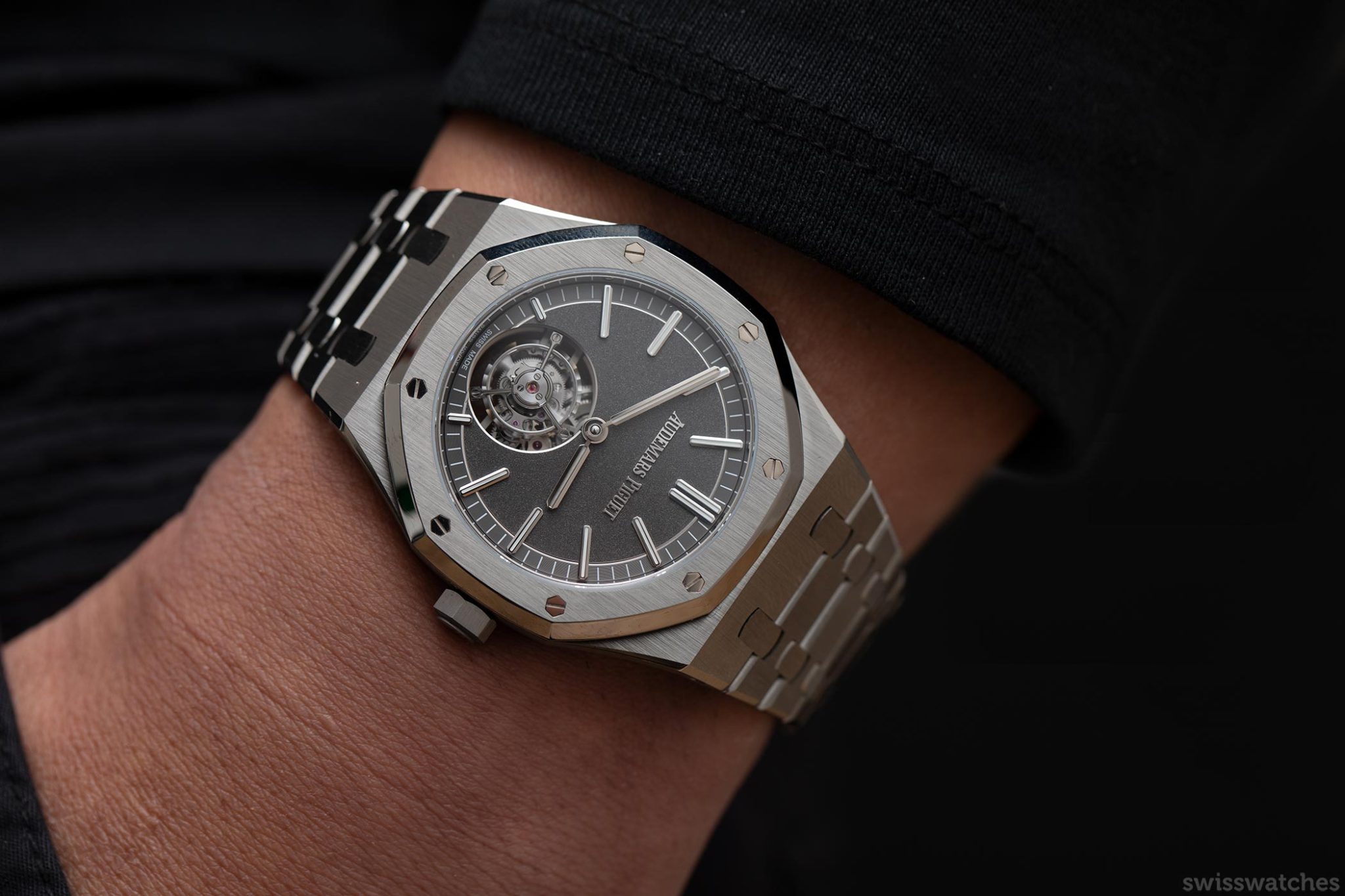
In other ways, despite the relatively rare material, the titanium timepiece stays true to Royal Oak form. As usual, the integrated bracelet with a triple-blade folding clasp, as well as the case with exposed white-gold screws, showcase satin-brushing and polished chamfers. Additionally, the case remains water-resistant to 50 m.
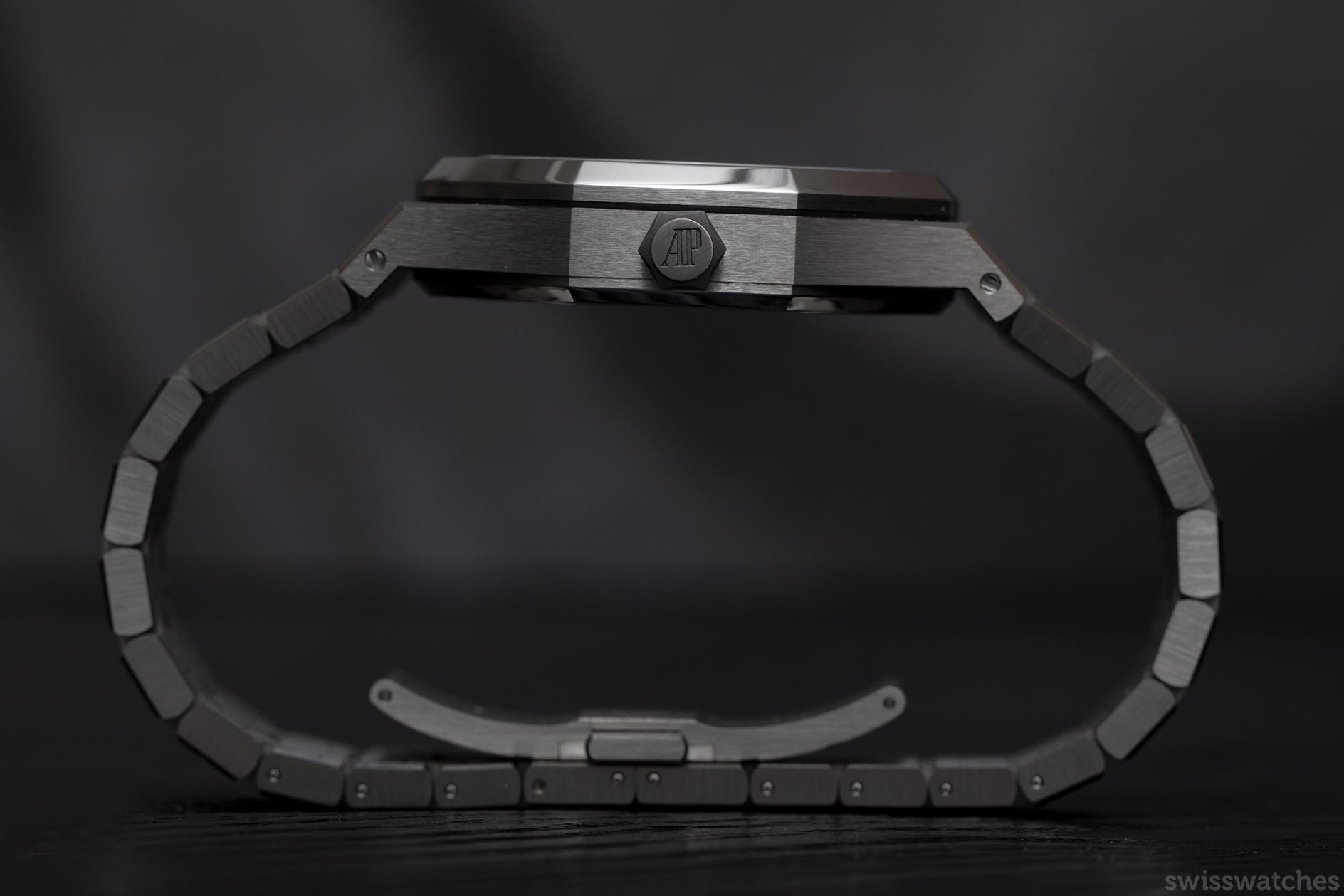
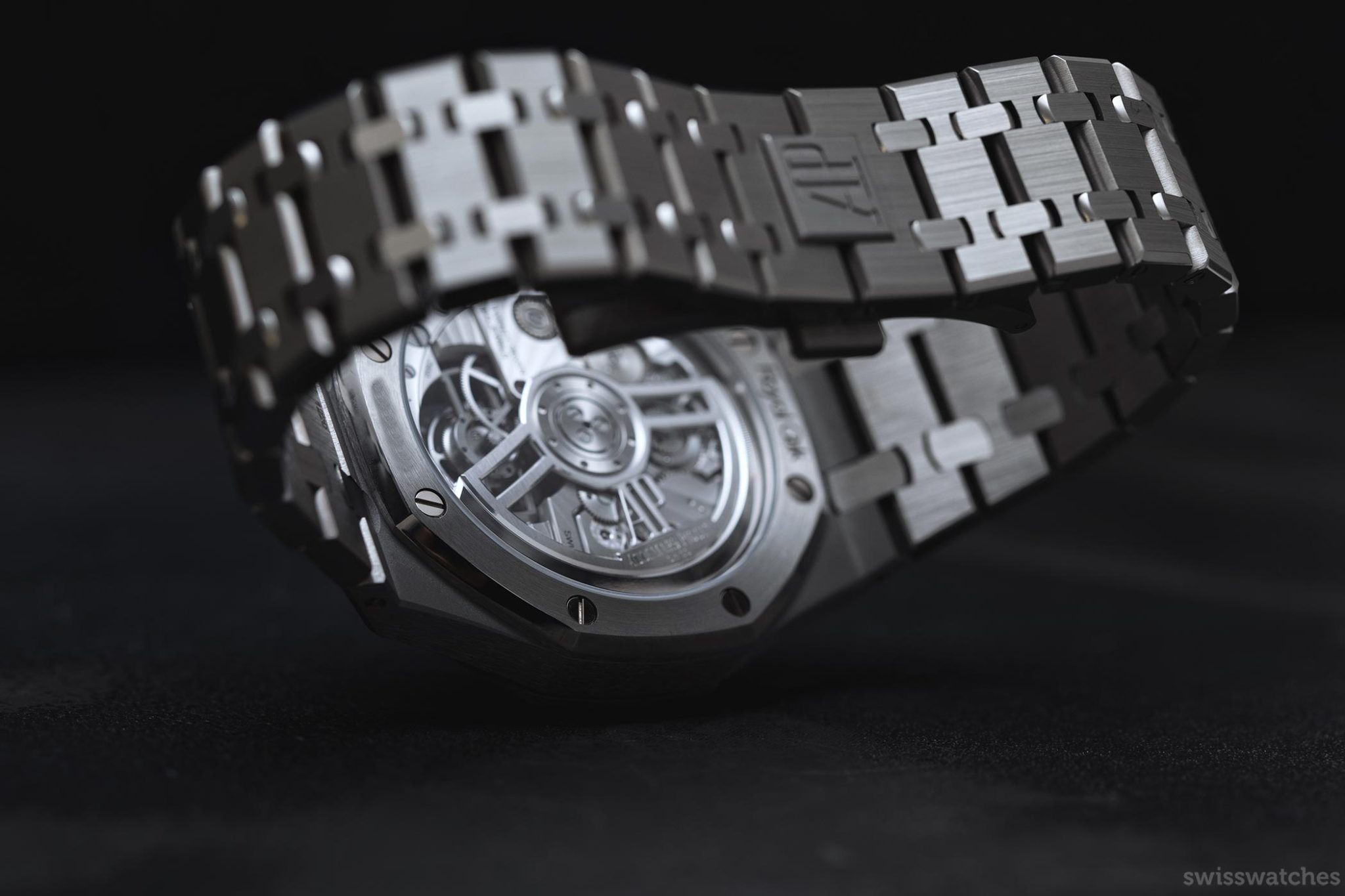
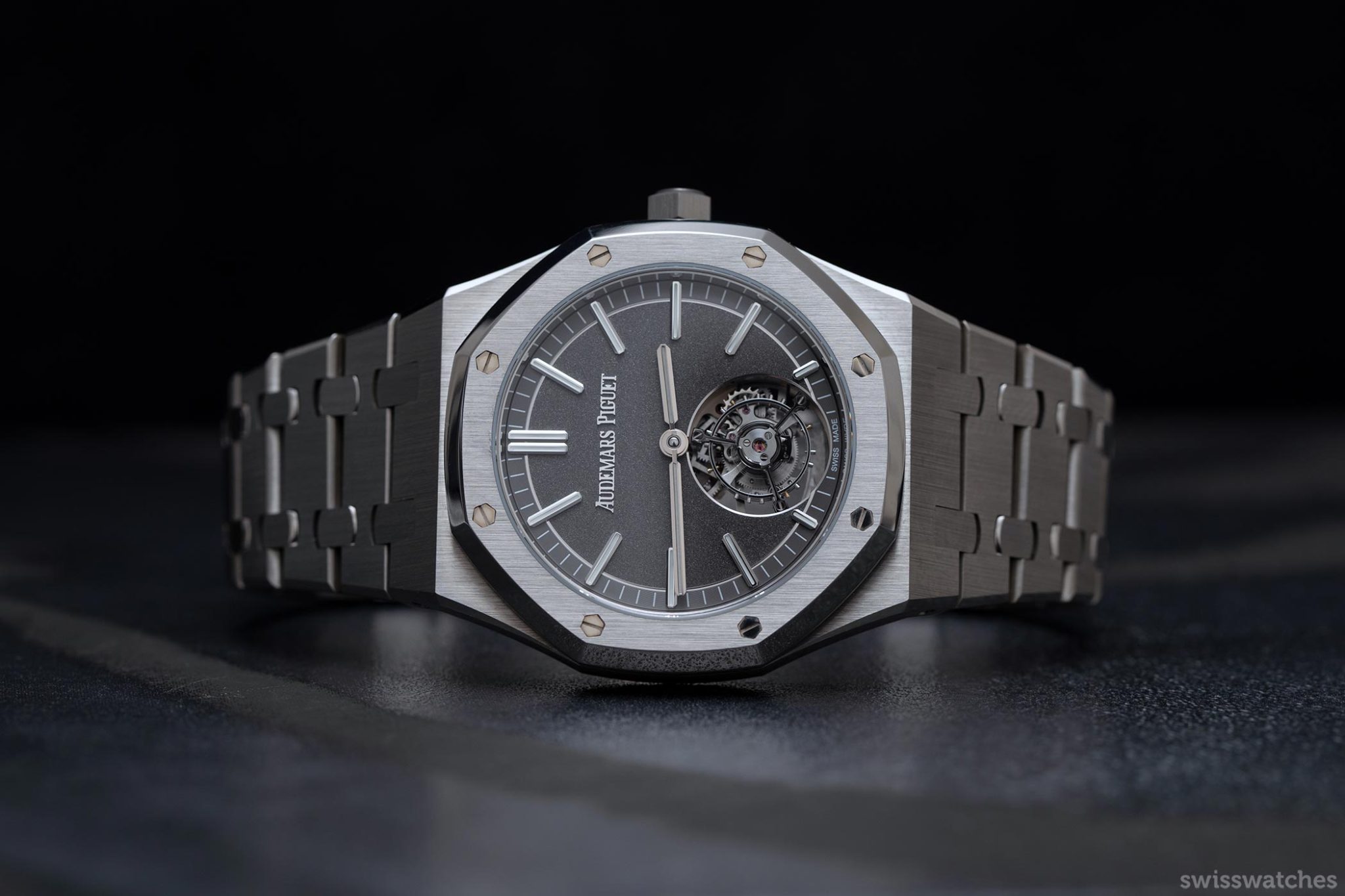
Regardless of personal tastes when it comes to titanium, the watch sits very well on the wrist. For the average wrist, which tends to measure roughly 18/19 mm, the Royal Oak‘s 41 mm diameter fits perfectly. Its dimensions also make complete sense; after all, the movement within was originally designed for the CODE 11.59 timepieces, which also measure 41 mm.
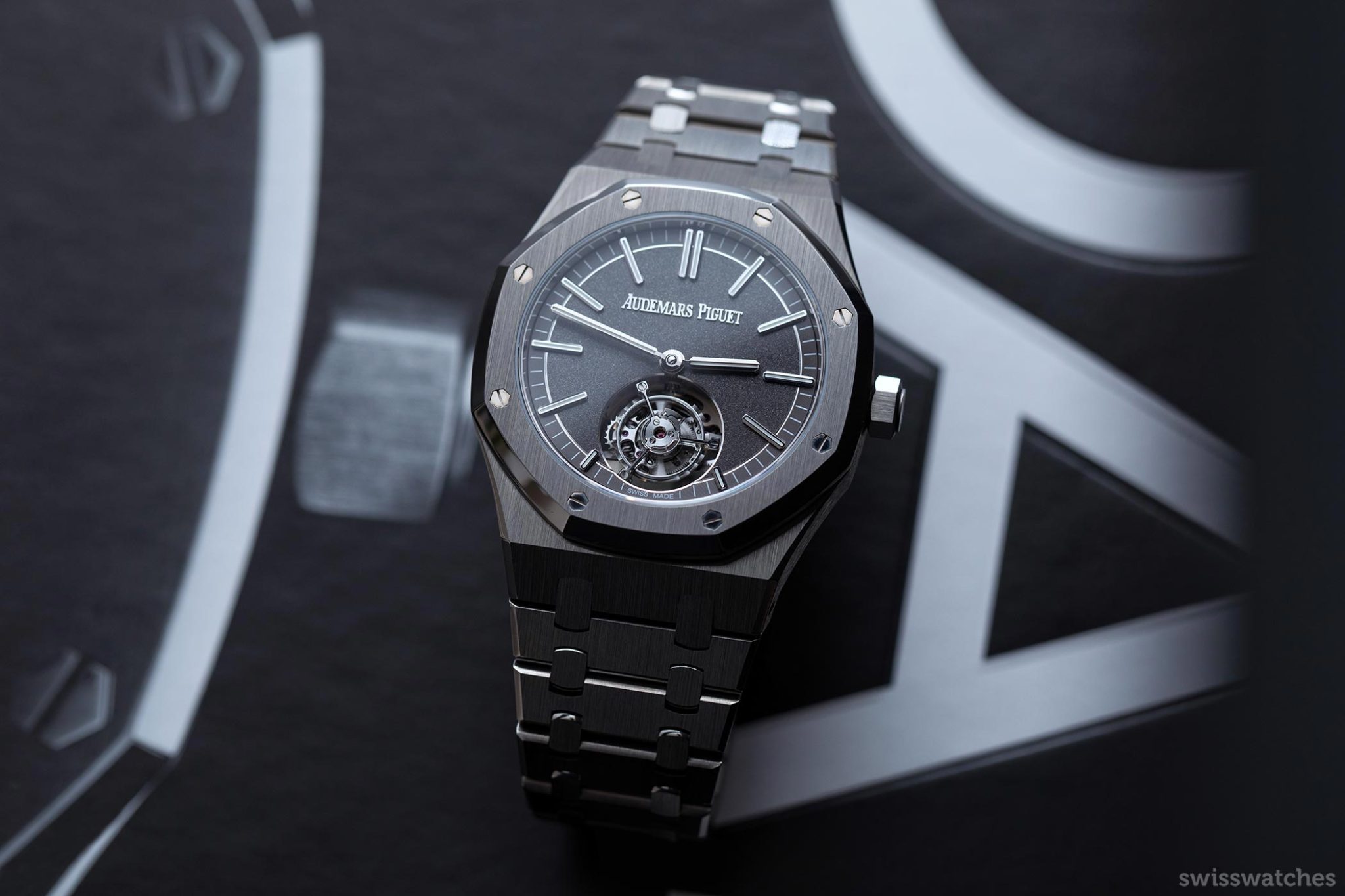
Looking to the future: The Dial
Metaphorically speaking, the AP Royal Oak Selfwinding Flying Tourbillon in titanium appears to be somewhat more of a step-sibling. The steel and pink-gold models’ dials showcase Evolutive Tapisserie. This decoration is commonly found on Royal Oak tourbillon models, with the recognisable tapisserie pattern gradually expanding outwards.
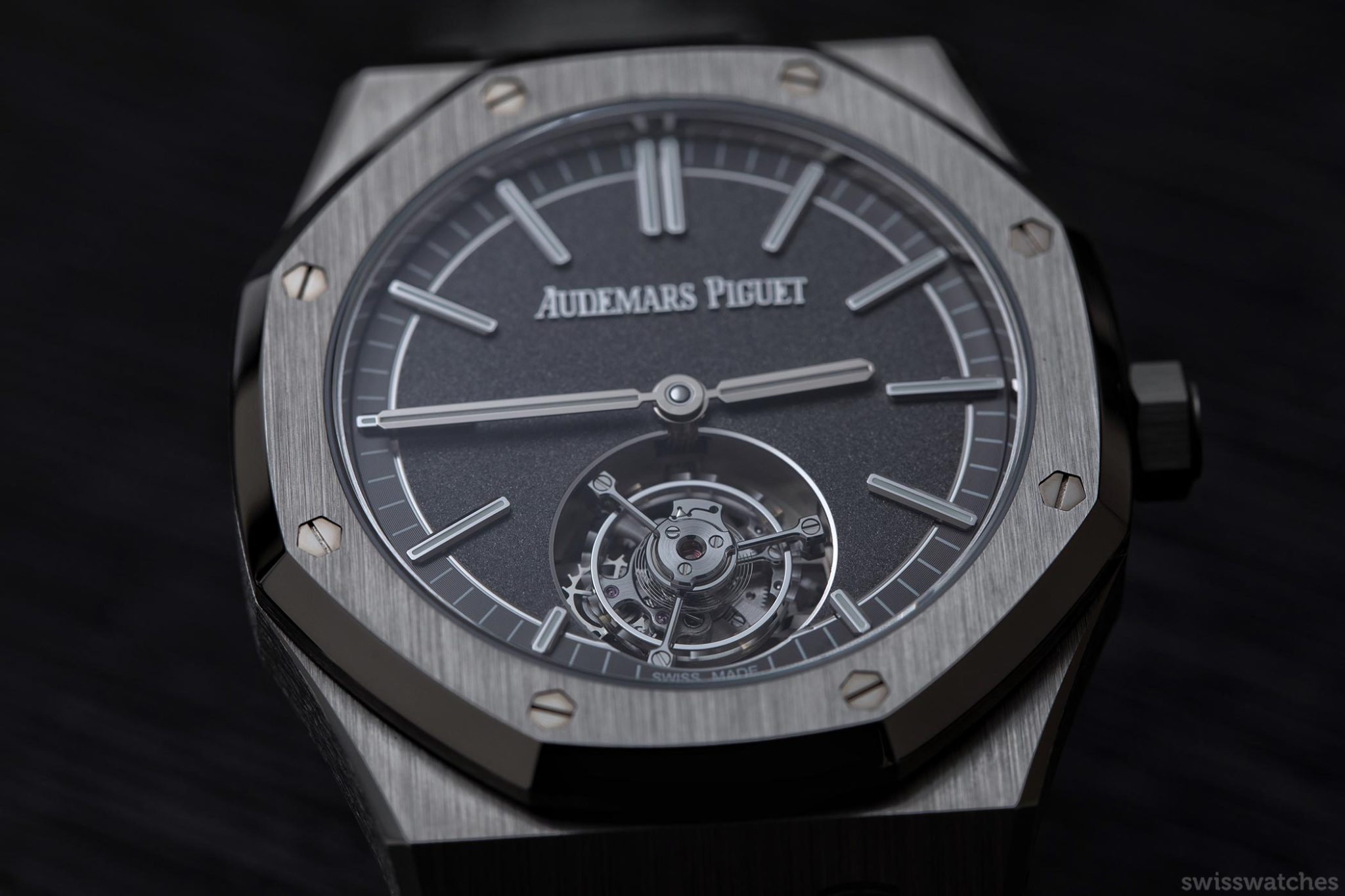
By contrast, the sandblasted dial is used solely in this one titanium Royal Oak. Subtly contrasting with the dial’s rugged texture, the time is indicated with 18-carat white-gold applied hour markers and Royal Oak hands. Both benefit from a luminescent coating for 24/7 legibility. Additionally, the low-key, slate-grey dial integrates a snailed chapter ring around the periphery, adding visual depth as well as legibility.
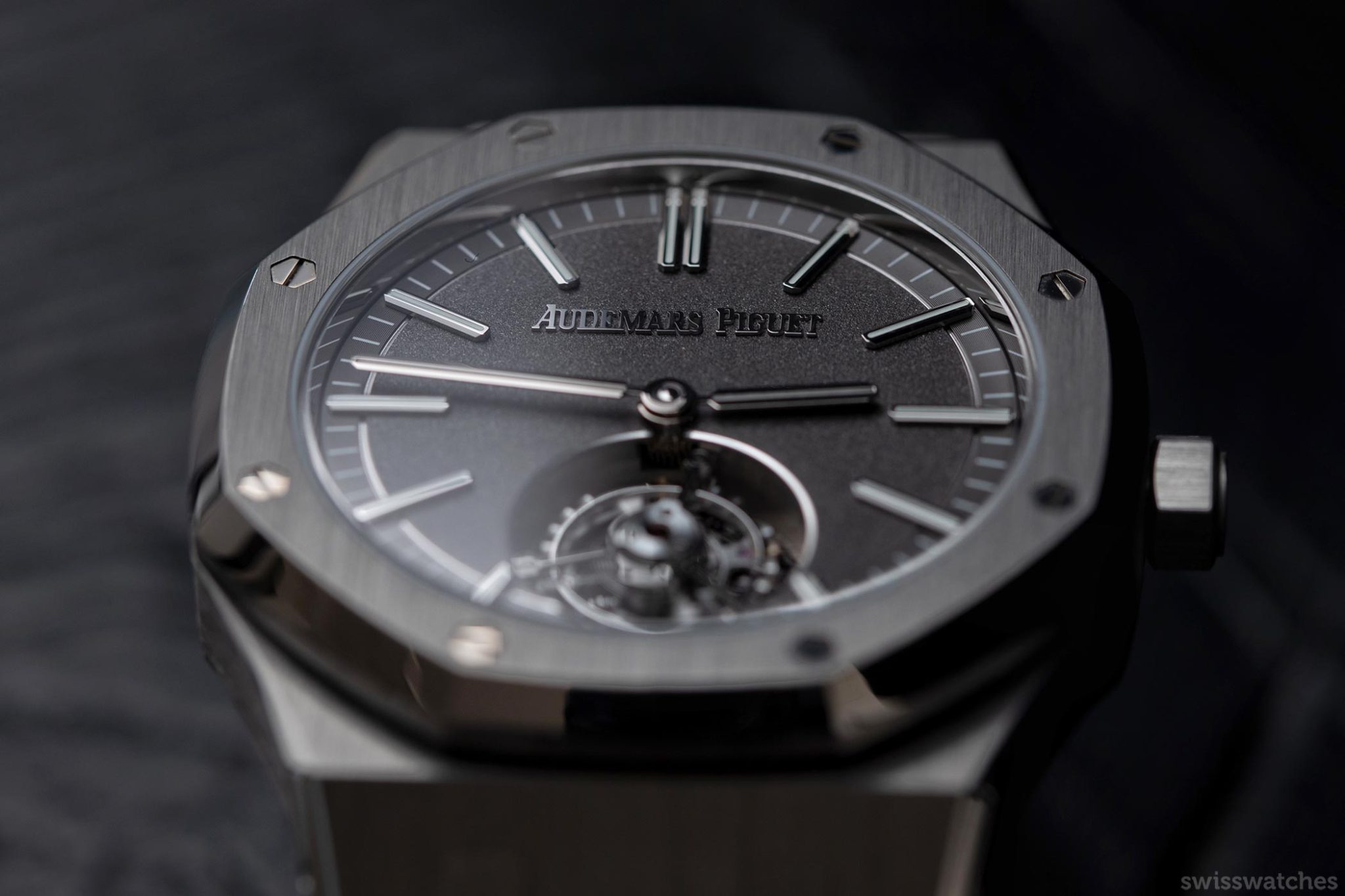
An Unusual Technique: The new AP logo
Notably, the dial also includes another novelty. Along with its siblings, it marks the first time that a Royal Oak has used the still-new AP logo, best-known for its initial introduction into the CODE 11.59 line. The reason for its fame is more than looking good or having first appeared in a brand new collection. Rather, it is the process that rouses the interest of horology fans. The chemical process used to create the logo, known as galvanic growth, took several years for AP to conceive and implement. There are several reasons for this.

Firstly, it took two years of development even to successfully place the logo on a lacquered dial. Secondly, galvanic growth is a complex process in itself, involving taking very fine layers of gold leaf and layering them on top of each other to create a 3D effect. And the gold layers were very fine indeed. The A and U, in particular, were problematic due to their thinness, in some places being thinner than a single hair. Each letter connects with links almost invisible to the eye, before being fixed in its entirety onto the dial, and held up by miniature legs. AP applies the whole 24-carat gold signature by hand, and you can almost see evidence of this when using a loupe.
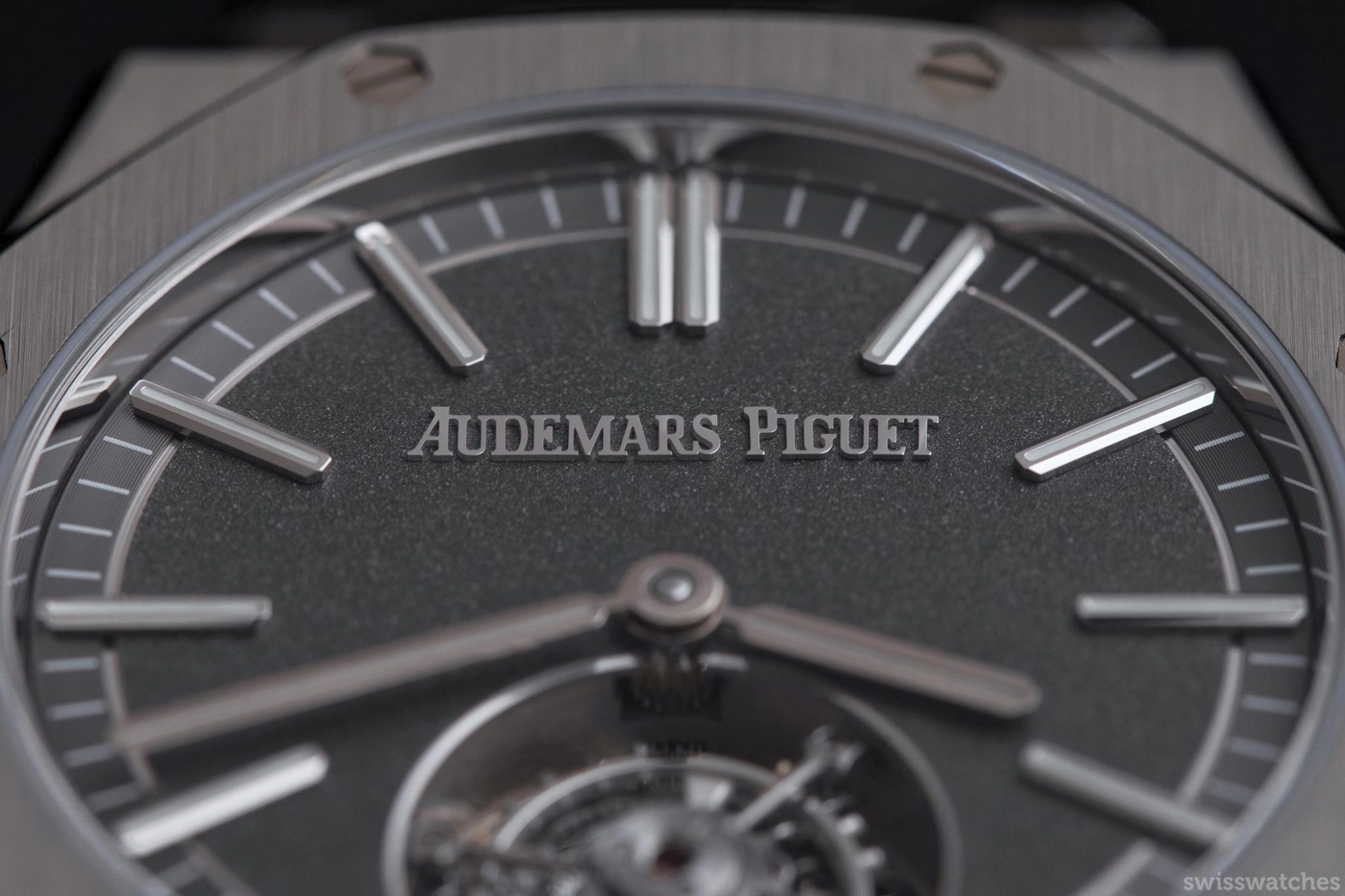
Another first: The movement
The new trio of watches mark the first time that the Royal Oak watch has used the in-house calibre 2950. The automatic movement was first introduced by AP back in 2019 for use in the CODE 11.59 watches, when CEO François-Henry Bennahmias already tipped us off that it was likely to appear in other lines. The calibre combines a flying tourbillon with a central, open-worked rotor. Furthermore, it provides a solid 65-hour power reserve plus a frequency of 3 Hz. Consisting of 270 components and 27 jewels, the movement is fully visible via the glare-proof sapphire crystal caseback. Consequently, AP spared no details in terms of decoration. Studying the model from the back, the wearer can see the likes of Côtes de Genève, satin-brushing, snailing and hand- polished chamfers – in other words, there is a fair amount to be admired.
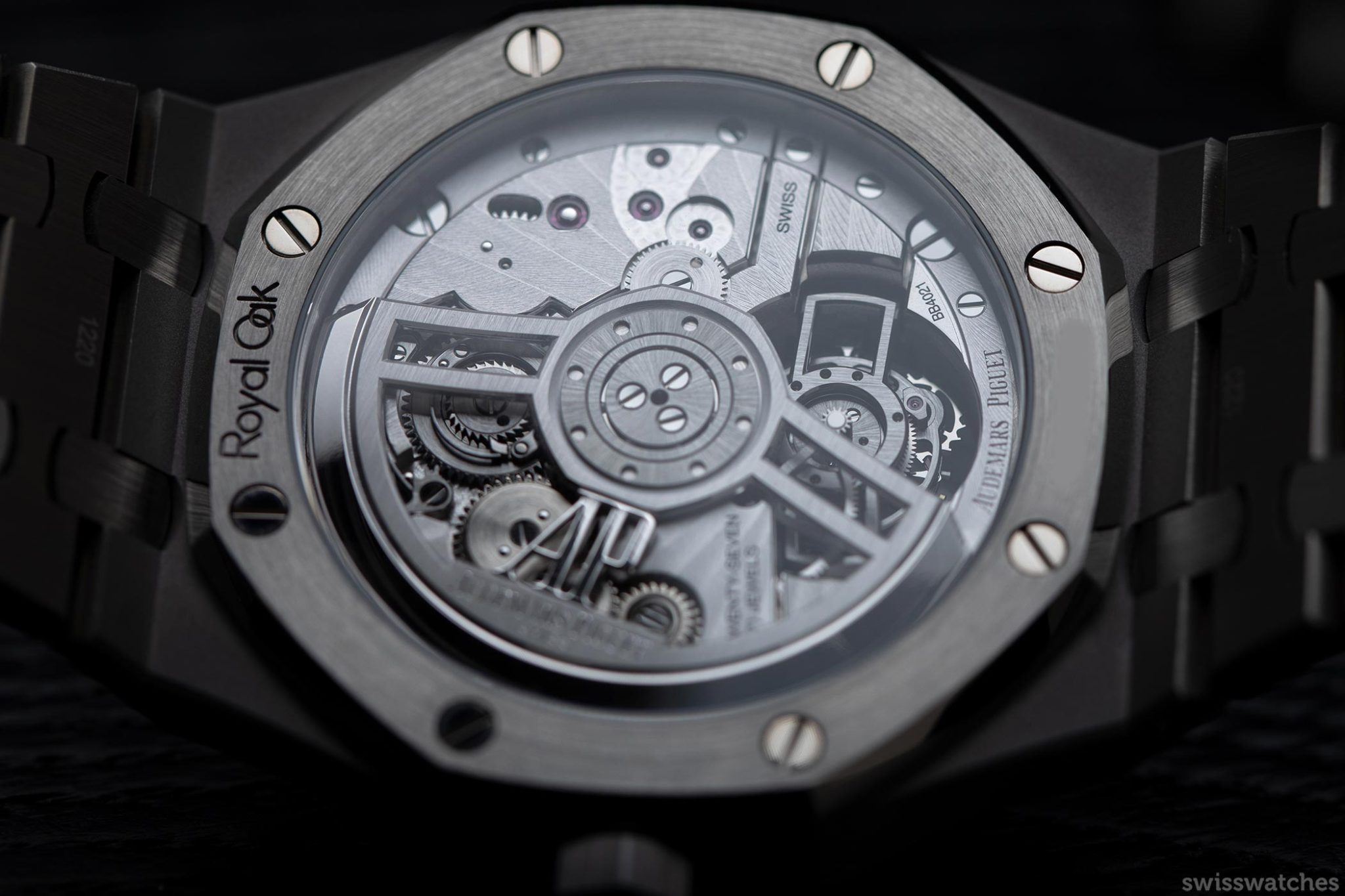
However, the most magical part of the calibre’s architecture is being able to see through the entire movement. Holding the watch up to one’s eye, you see directly through the tourbillon, from one side of the watch to the other, almost like a viewing window, thanks to the sapphire crystal caseback and skeletonised AP rotor. The effect is almost like wearing a virtual reality set as you peer through.
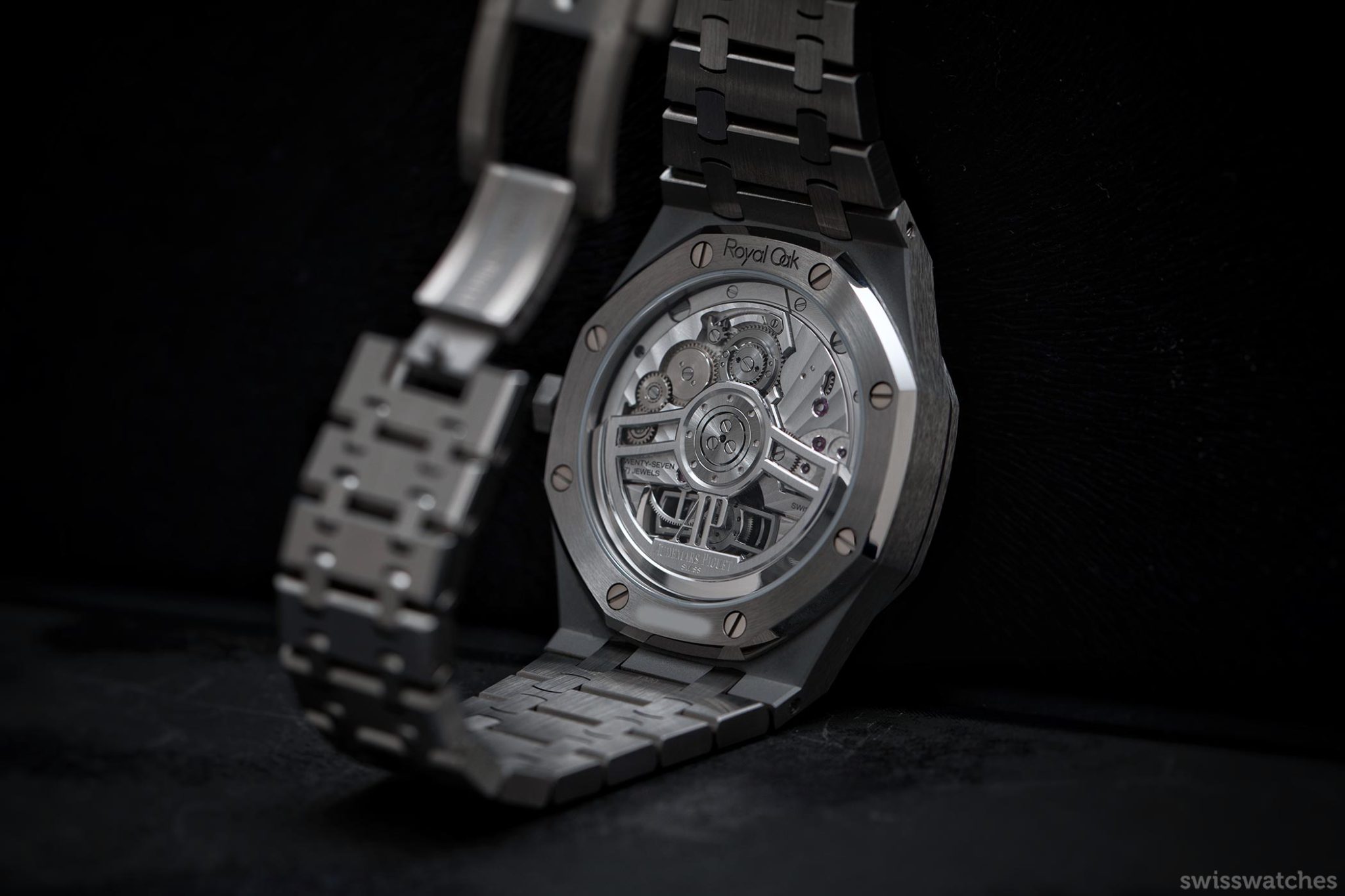
The Flying Tourbillon
Tourbillon versus flying tourbillon: What’s the difference?
Tourbillons were famously patented by Abraham-Louis Breguet back in 1801, to enhance precision in pocket watches. The gravity-defying regulating organs were actually necessary back then; pocket watches were not only generally stationary, but also often kept horizontally on a surface, or, of course, vertically in a pocket. Therefore, the inclusion of an escapement and balance wheel in a rotating carriage served to defy the effects of gravity, balancing out positional errors.

Meanwhile, the flying tourbillon was conceived by Alfred Helwig in Glashütte in 1920. It took watchmaking craftsmanship a step further, with the tourbillon being mounted on one side only. This means that the complication does not attach to the dial with a bridge. Rather, it is only supported from below – thus giving the impression that it is “flying”.
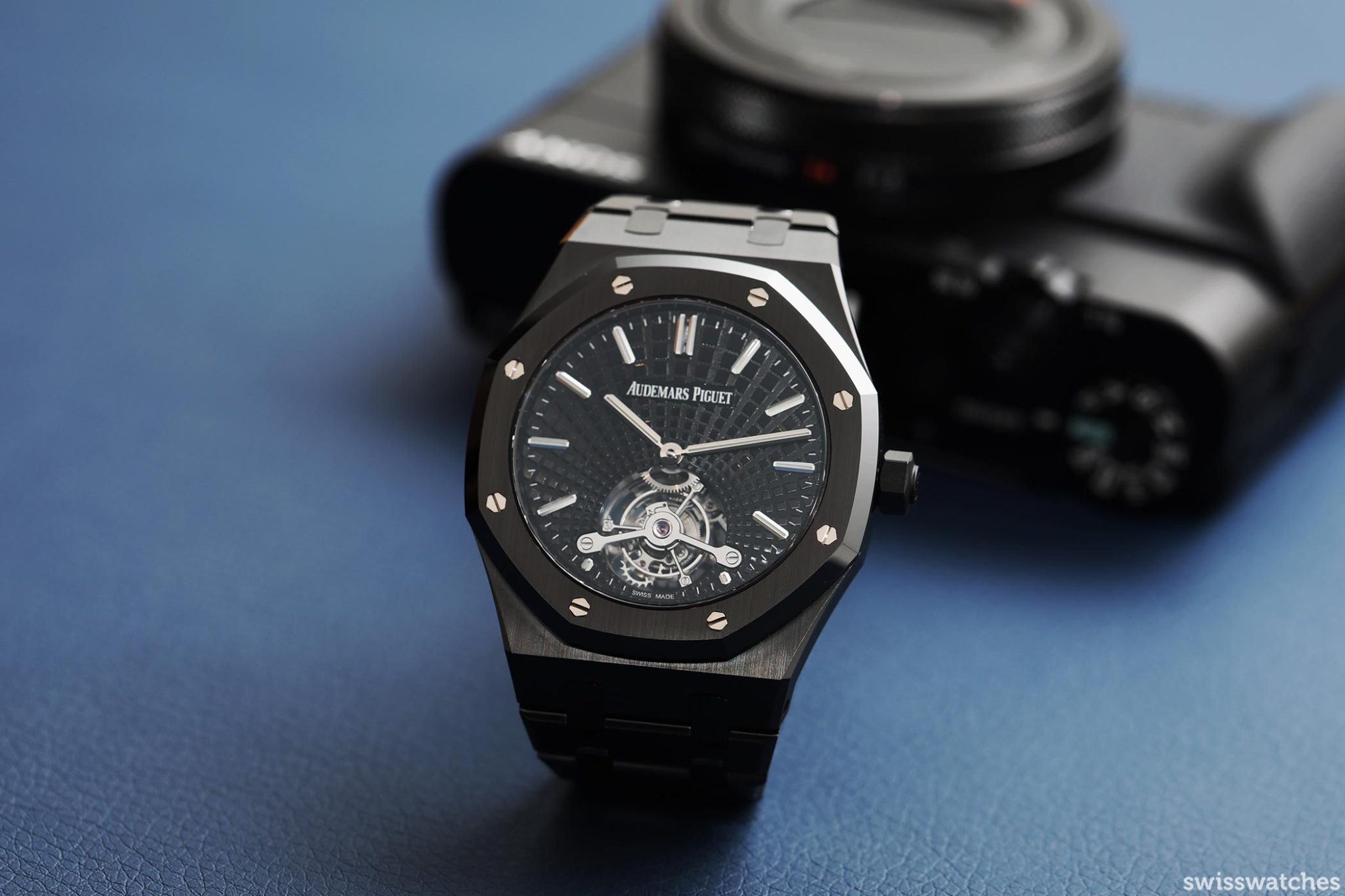
Royal Oak and the tourbillon
When it comes to creating tourbillons, Audemars Piguet also have form in this department. In fact, the horology house manufactured the first ever flying tourbillon into a wristwatch in 1986. Meanwhile, the Royal Oak line first saw the introduction of a tourbillon in 1997. The Ref.25831, introduced as a special limited edition, marked 25 years of the Royal Oak.

Photocredit © Christie’s
Flawless execution: The flying tourbillon and the Ref. 26530TI
These days, flying tourbillons are more a show of craftsmanship and watchmaking ability than a necessary complication. Furthermore, flying tourbillons – and tourbillons in general – can be tricky to integrate into a watch’s design. Some even argue that tourbillons need not be visible, with models such as Patek Philippe’s 10 Day Tourbillon Ref. 5101P only showing the complication from the back. While to some this will seem an outrage, others will admit it can make sense. Amidst indices, hands, subdials and dial patterns, a tourbillon can make a dial look cluttered or over the top.
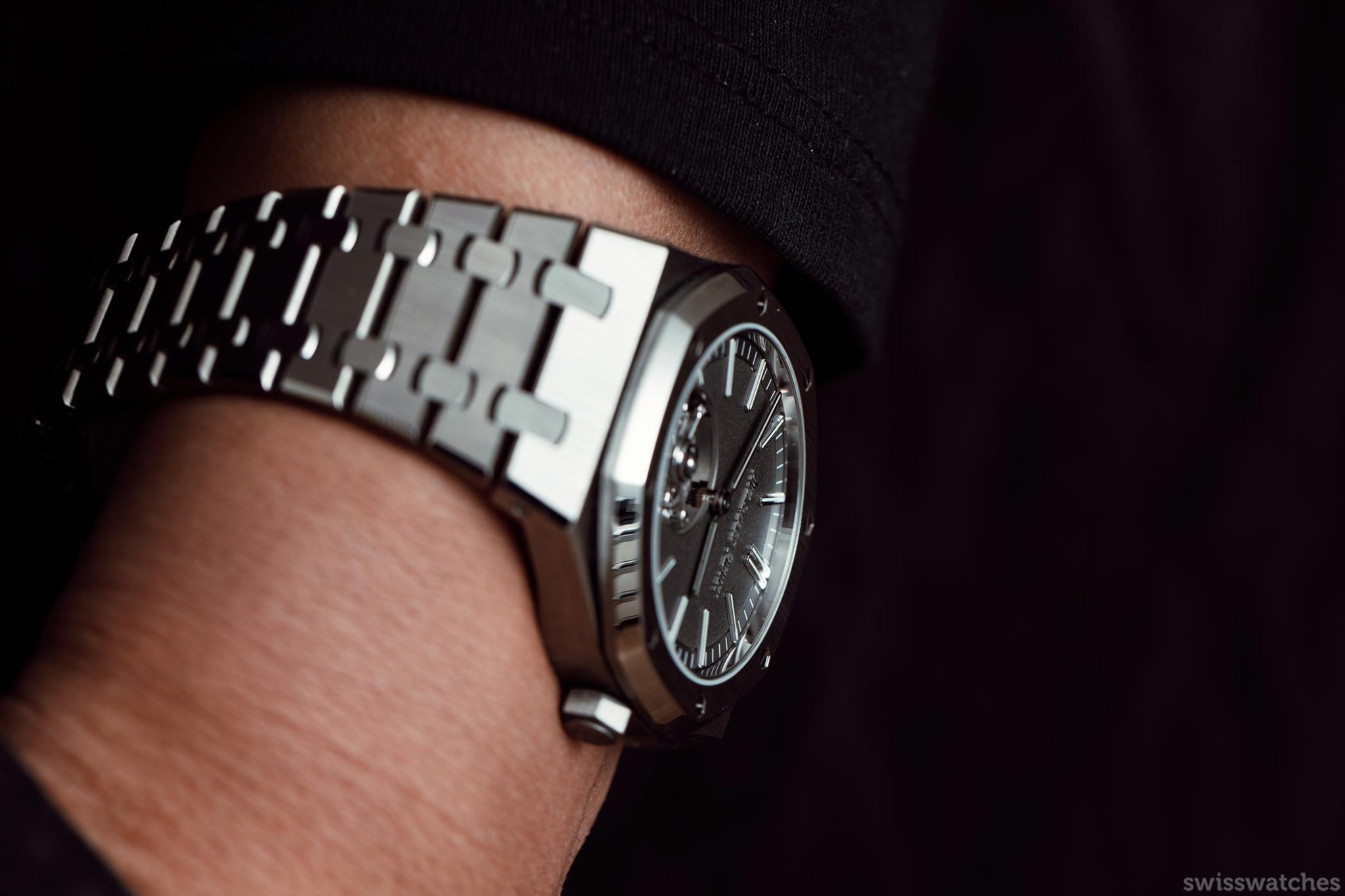

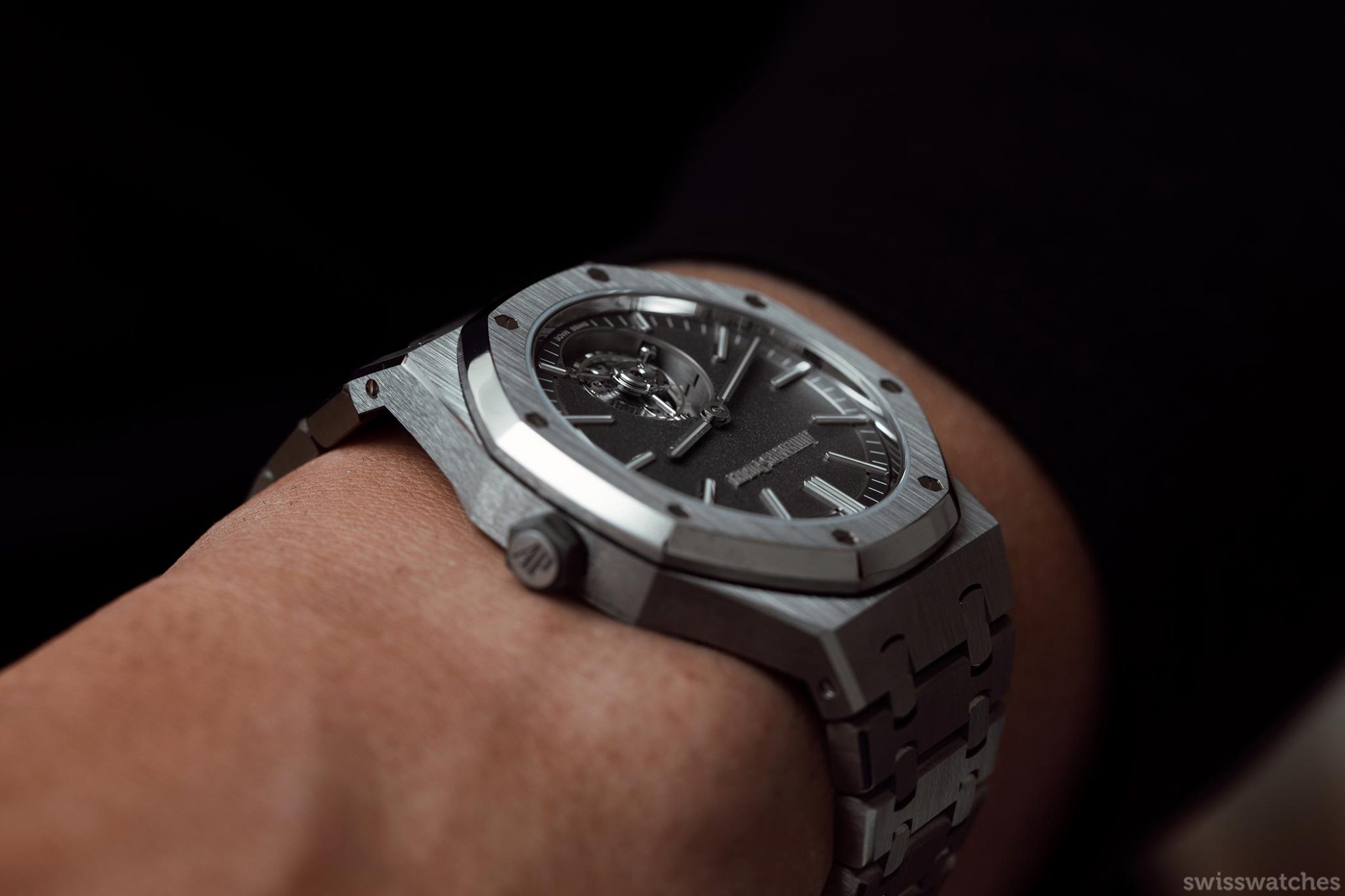
However, this is certainly not the case with the AP Royal Oak Selfwinding Flying Tourbillon in titanium. The watch’s dial is commendably minimalist. It doesn’t even offer a seconds hand – the flying tourbillon can technically provide this function anyway, even without an added pointer. Thanks to the understated design of the dial, the complicated model can still fly under the radar.
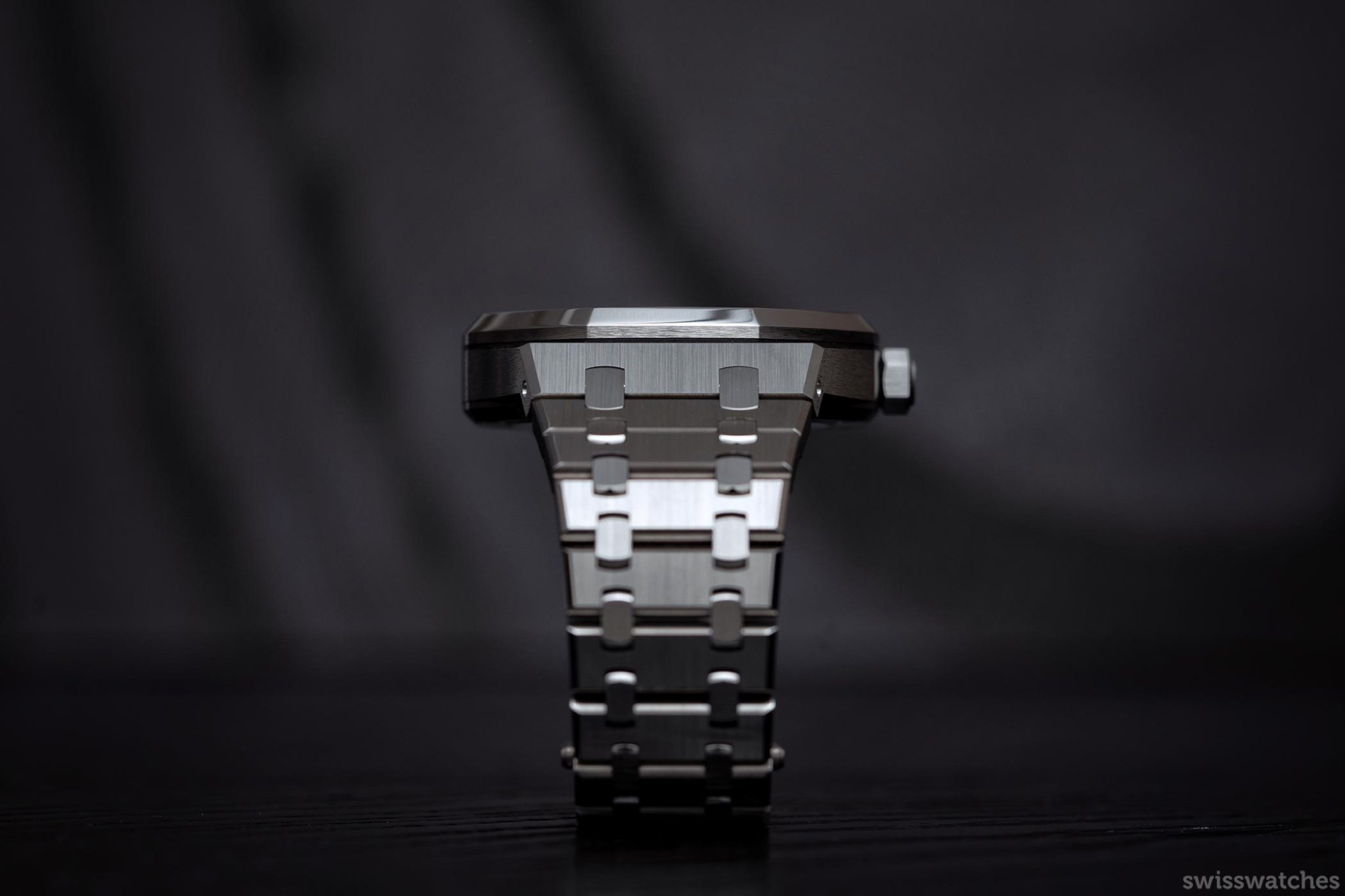
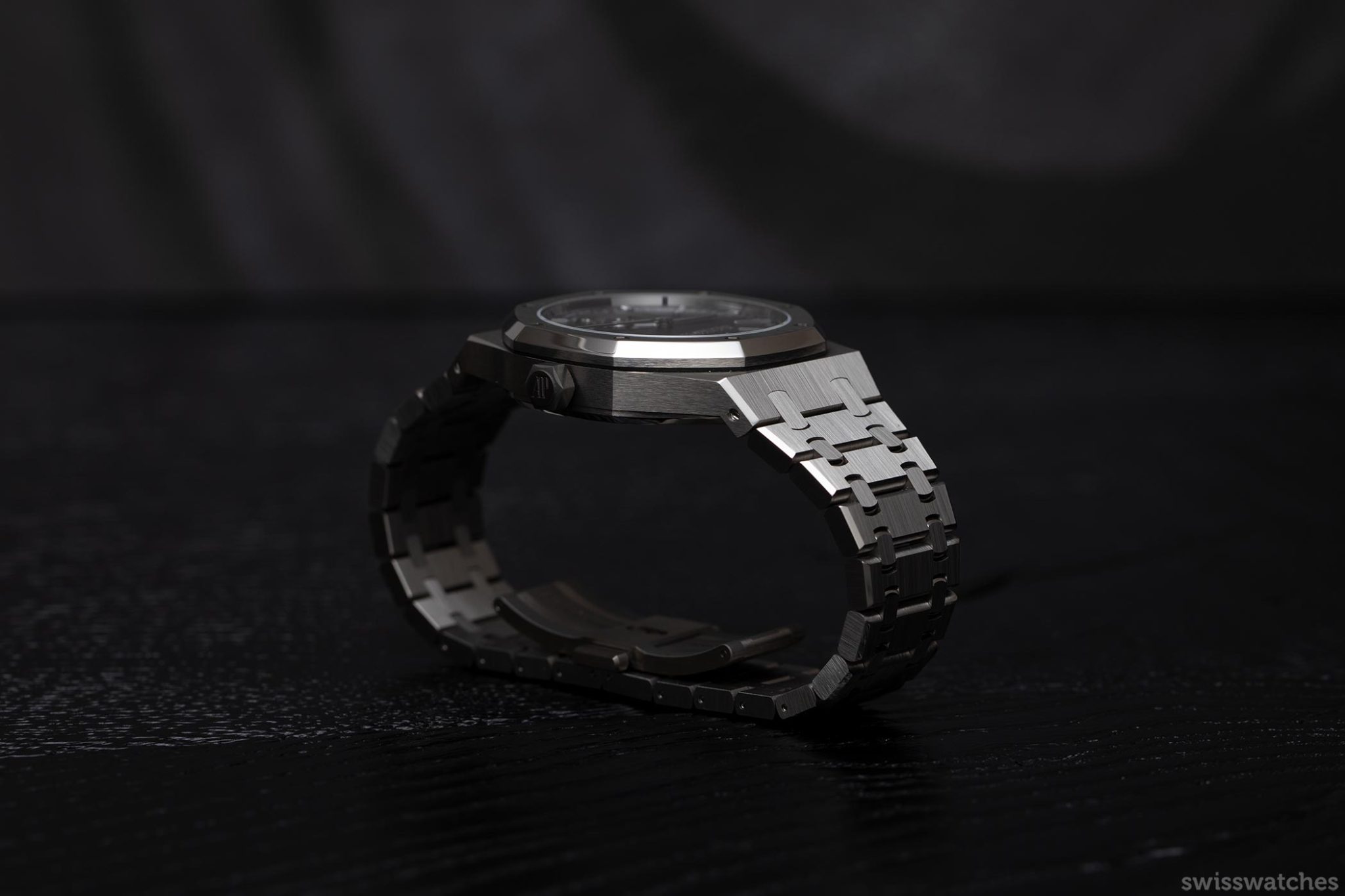
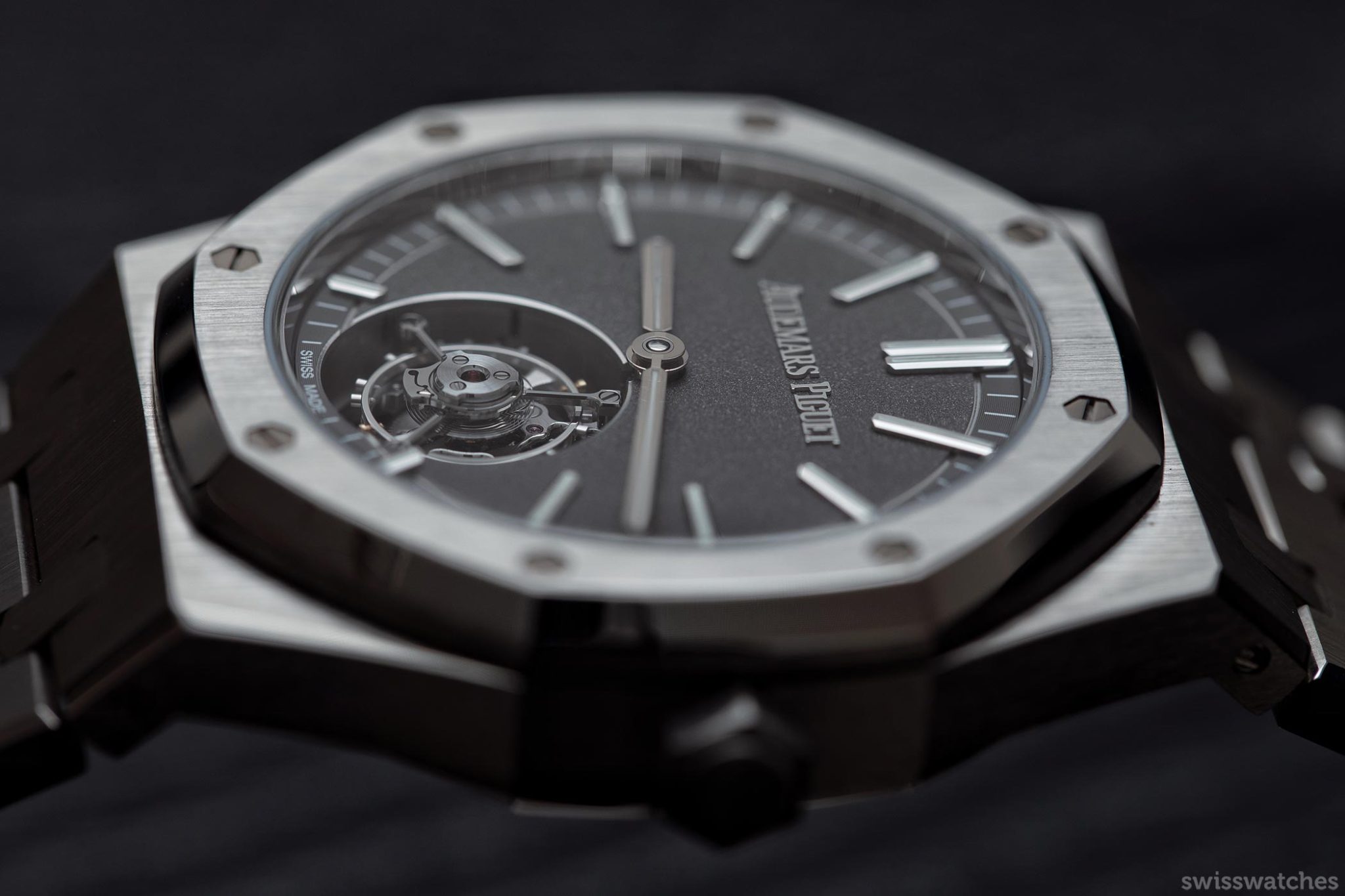
The Verdict
The Royal Oak Selfwinding Flying Tourbillon in titanium balances exquisite watchmaking with low-key aesthetics. Thus, it potentially offers the key to unlock a new clientele looking for a complicated piece that is a bit more edgy, yet subtler than the average Royal Oak. What’s more, we can expect to see more of this kind of contemporary dial in the future. According to Michael Friedman, Head of Complications at AP, the titanium model’s design aimed to introduce “updated aesthetics for the new decade.”
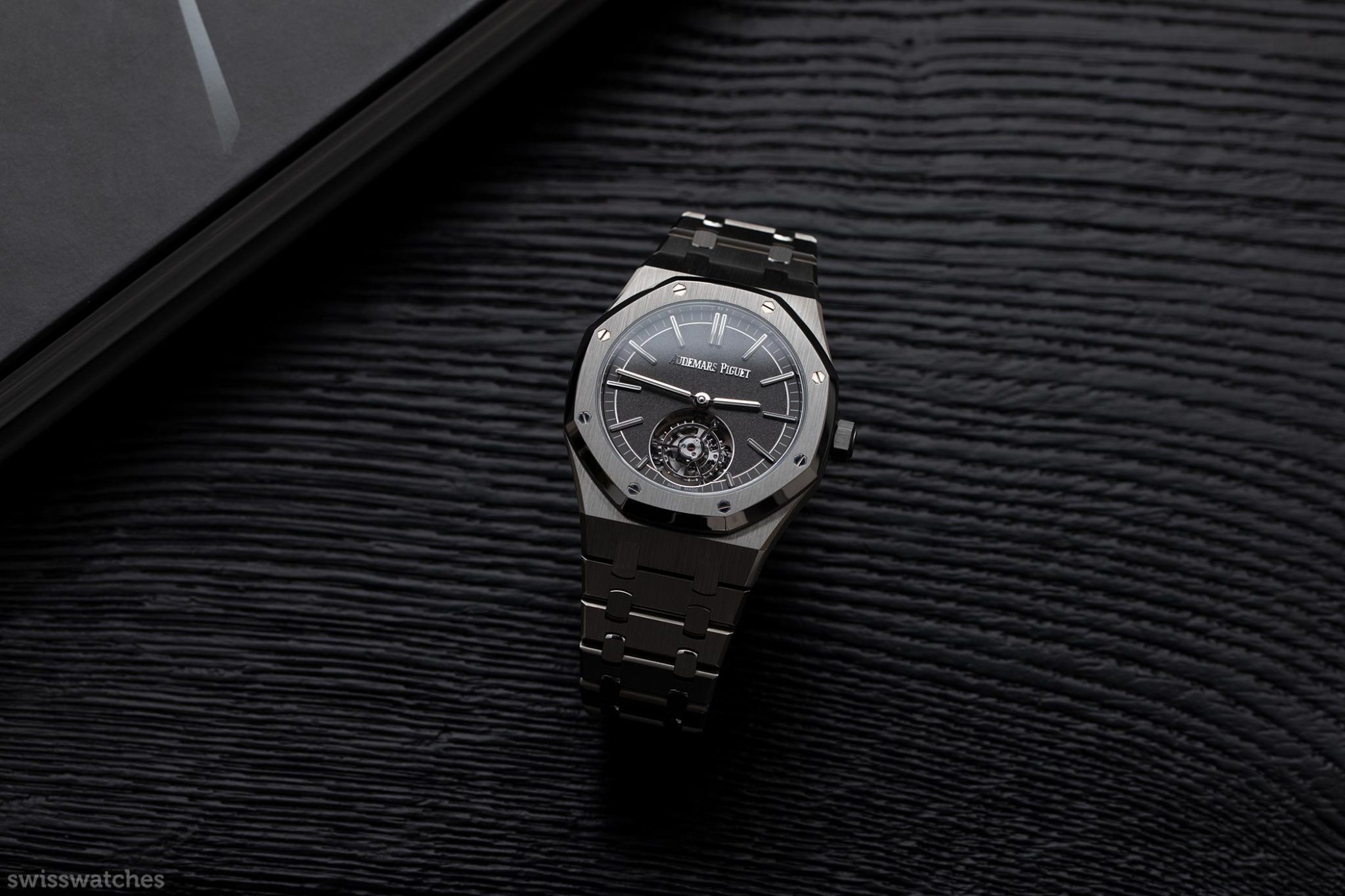
This is a watch that decidedly breaks with the Royal Oak’s design codes in the best way possible. It is a Royal Oak with a rarely seen flying tourbillon, unusual choice of material, new dial without tapisserie, and movement never previously seen in the line. The result is an extraordinary, boundary-breaking timepiece that is a testimony to the AP design team’s capability and vision.

Finally, the new design and impressive complication unite to create a more versatile feel for what is typically one of the most conspicuous watches out there. The combination of an unexpectedly urban, chilled aesthetic and an excellent example of the world’s highest level of watchmaking works perfectly. As the horology house famously points out, and certainly proves with this unparalleled and unique model: “To Break the Rules, You Must First Master Them”.
FEATURES
Height: 10.4 mm


